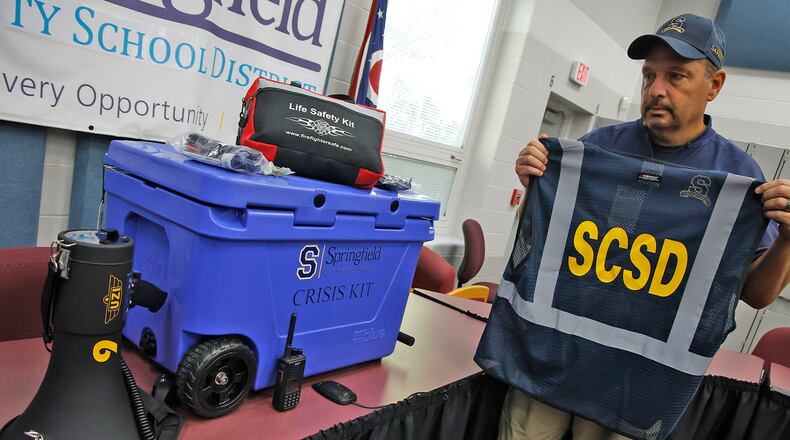“Safety and security will always be our district’s top priority,” said Springfield Superintendent Bob Hill. “We are constantly analyzing and adjusting our systems and internal processes, with the goal of being one step ahead of any potential crisis and keeping our Wildcat Family out of harm’s way.”
The Springfield City School District has invested $1.5 million in school security since last year to “prioritize the safety and security of students and staff,” and a large portion is being financed through grant funds.
One change for Springfield: providing first responders with 24/7 access to buildings.
School buildings and internal doors have been locked and require badges or master keys to get into them. Only employees had that. Now, any police or firefighters will have access with their ID badges to get in during emergency situations. The district used the first responders’ existing badges and integrated those into the district’s systems to allow them to enter buildings.
Other areas Springfield schools invested for upgrades:
— adding equipment such as crisis kits that have first-aid supplies, megaphone, radio and more that may be needed in an emergency;
— replacing all cameras on a rotating basis and adding cameras to hallways that don’t have them as well as in outside dead spots;
— upgrading safety software to communicate faster with first responders;
— and participating in a community-based violence reduction committee to investigate and implement a research-based violence prevention program.
During the last year, Greenon Local Schools created a district-wide safety committee of teachers, administrators and parents who meet on a regular basis to discuss safety concerns and provide suggestions for policies and practices.
The committee is scheduled to meet quarterly and as needed, with the recent meetings held on Aug. 7 and Sept. 27.
“The most recent safety suggestion was to ensure our new staff members were adequately educated and trained in our safety and emergency plans and protocols,” said Vana Beekman, communications and community relations specialist.
This committee also implemented a safety week during the first full week of the school year to help educate students and staff on the safety procedures in the district.
During that week, each day focused on a different safety topic that teachers and staff reviewed with students in an age-appropriate format and had a drill related to the topic. The topics included fire safety, tornado safety, emergency drills, meet and greet with the School Resource Officer, ‘see something, say something,’ and general building rules and safety measures.
The district also has its new facility with a security system that has multiple cameras and School Resource Officer Vaughn Apel.
Beekman said each safety measure plays a “vital role in a safe and secure learning environment” for students and staff.
“The safety committee aims to address potential hazards, assess and mitigate safety risks, and implement safety protocols. Our SRO maintains security within our building and builds positive relationships with students and the community. The security systems add an additional layer of protection for our facilities and students,” she said.
One of Clark-Shawnee Local School’s upgrades include installing protective film on select windows and doors within the district to enhance the current safety protocols. That work will be done in phases.
Superintendent Brian Kuhn said the goal of this initiative is to provide additional protection to identified areas of the school buildings.
At Global Impact STEM Academy, Northeastern Local Schools and Graham Local Schools, they used grants toward safety upgrades.
GISA is in their second year of having a full-time School Resource Officer on campus, through a partnership with the Clark County Sheriff’s Office, for a cost of a little over $62,000 per year, said Josh Jennings, founding director and superintendent. The school has also made security upgrades to the building that was funded by a grant of over $100,000 through the governor’s office.
Northeastern added Megan Forrest as an SRO and now has two officers in the district, plus officials incorporated Raptor Background Check Technologies, which gives people access to the buildings by checking a valid driver’s license or state ID card. They spent about $160,000 on safety equipment, such as the Raptor Technologies, radios and other resources, with $149,900 being a safety grant, and about $160,000 on the SROs.
Graham also received $100,000 per building from the governor’s third round of safety grants, said Superintendent Chad Lensman. The district is working to add more cameras to each building, update signage, add a new middle school entry door, fix high school outdoor fencing, add entry window film and install door-locking pins for all classrooms.
“Safety and security are a priority in the district and the grant dollars have helped add additional security features in all of the buildings in the district,” Lensman said.
In the Triad Local School District, Superintendent Vickie Maruniak said they spent the last year focused on safety, training with staff each month and adding multiple safety features.
Maruniak said the biggest changes made district-wide include adding vestibule entrances for visitors to come into a secure area and be given access to the rest of the building. That cost just under $35,000 and was paid through a safety grant.
Triad also upgraded all the fire doors to shut and lock in case of an emergency, costing $39,000, and added an egress window for $50,000 to each high school classroom.
“During the 2023-24 school year, our focus is on training students and the community,” she said.
About the Author

